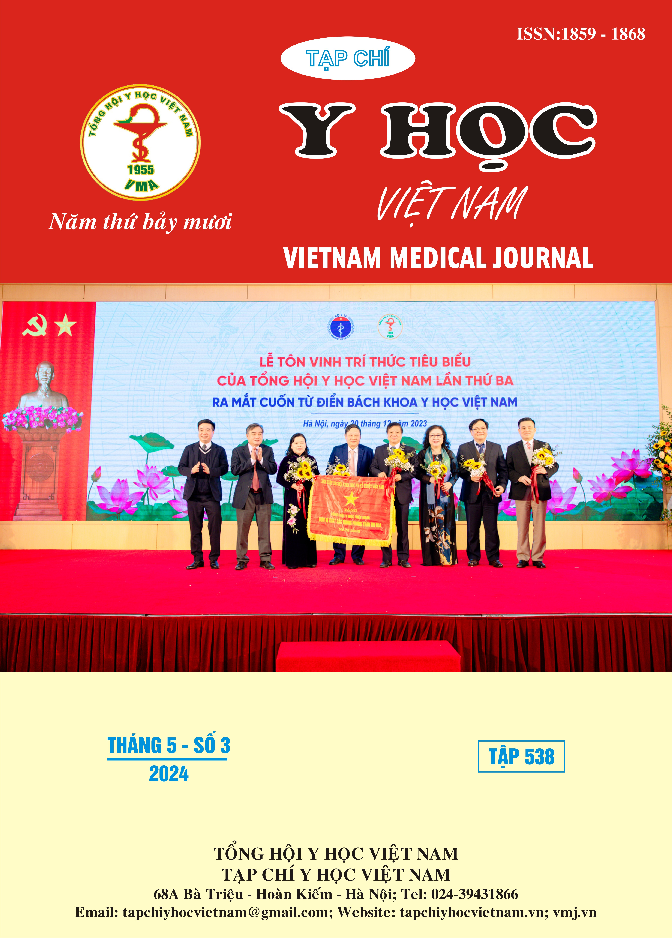CHARACTERISTICS OF HLA- ANTIGENS AND COMPATIBILITY IN LIVING RELATED -KIDNEY TRANSPLANTATION AT VIET DUC HOSPITAL
Main Article Content
Abstract
Objective: To investigate the characteristics of HLA antigens and HLA compatibility in blood-related kidney transplant pairs at Viet Duc Hospital. Pateints and Research Methods: Clinical description and cross-sectional study on 84 pairs of kidney transplant donors and recipients from the same blood lineage. Study period: from January 2018 to December 2022. Research parameters include the age of donors and recipients, blood relationship (parent-child, sibling, etc.), HLA characteristics for each allele (A, B, DR B), subgrouping under each allele, and compatibility levels (3/6, 4/6, 5/6, 6/6). The frequency of each allele appearing in donors and recipients is also evaluated. Results: The minimum age of kidney donors is 30 years, with a maximum of 64 years, and a mean ± SD of 49.51 ± 7.30. Kidney recipients range from 18 to 58 years old, with a mean ± SD of 29.42 ± 6.57. Recipients between the ages of 21-40 constitute the majority at 94.05%. HLA compatibility between donor-recipient pairs from the same blood lineage is relatively high, primarily at 3/6 - 4/6 levels, accounting for 84.52%. The lowest compatibility is 2/6, observed in 2 cases (2.38%) among siblings. Seven cases show complete HLA compatibility at 6/6, mostly among siblings (57.14%). The most common alleles are HLA-A02 and HLA-A11, accounting for 23.8% and 35.4%, respectively. High-frequency alleles include A02, A11, A24, A29, A33, B15, DRB1*12, among others. Conclusion: HLA compatibility in related kidney transplantation is relatively high, predominantly at 3/6 - 4/6 levels, with a rate of 84.52%. The most common alleles include A11, HLA-B15, and HLA-DRB1*12
Article Details
Keywords
HLA, living related- kidney transplantation
References
2. Foster B.J., Dahhou M., Zhang X., et al. (2014). Impact of HLA mismatch at first kidney transplant on lifetime with graft function in young recipients. Am J Transplant Off J Am Soc Transplant Am Soc Transpl Surg, 14(4), 876–885
3. Hà Phan Hải An và cs (2012). Ảnh hưởng của mức độ hòa hợp HLA lên chức năng thận ghép sau 18 tháng ghép thận. Tạp Chí Nghiên Cứu Y Học, Phụ trương 80(3B), 28–33.
4. Lê Xuân Hải, Bùi Văn Mạnh (2013). Nghiên cứu tần suất kiểu hình Hla ở bệnh nhân dư tuyển ghép thận và người dự tuyển hiến thận tại bện viện 103. Tạp Chí Y Học Việt Nam, Tháng 8-Số đặc biệt(409), 453–457.
5. Nguyễn Thị Hảo (2018). Nghiên cứu đặc điểm HLA ở bệnh nhân có chỉ định ghép thận tại Bệnh viện TW Huế. Tạp chí Y Học Việt Nam, 466(Số đặc biệt), 621–627.
6. Hieu H.T., Ha N.T., Song L.H., et al. (2019). Association of Human Leukocyte Antigen Haplotypes With End-Stage Renal Disease in Vietnamese Patients Prior to First Transplantation. Transplant Proc, 51(8), 2549–2554.
7. Phạm Lê Nhật Mnh và cs (2018). Khảo sát định danh HLA của người đăng ký cho thận tại Bệnh viện Chợ Rẫy TP. HCM. Tạp chí Y Học Việt Nam, 466(Số đặc biệt-Tháng 5), 563571
8. Hoa B.K., Hang N.T.L., Kashiwase K., et al. (2008). HLA-A, -B, -C, - DRB1 and -DQB1 alleles and haplotypes in the Kinh population in Vietnam. Tissue Antigens, 71(2), 127–134.
9. Que T.N., Khanh N.B., Khanh B.Q., et al. (2022). Allele and Haplotype Frequencies of HLA-A, -B, -C, and -DRB1 Genes in 3,750 Cord Blood Units From a Kinh Vietnamese Population. Front Immunol, 13, 875283.
10. Fejzić E., Karamehić J., Eminović I., et al. (2017). HLA Genotyping in Patients with End-Stage Renal Disease Waiting For Cadaveric Renal Transplantation in Federation of Bosnia and Herzegovina. Open Access Maced J Med Sci, 5(1), 1–5.


